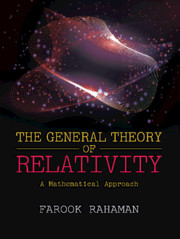Book contents
- Frontmatter
- Dedication
- Contents
- List of Figures
- List of Tables
- Preface
- Acknowledgments
- Chapter 1 Tensor Calculus — A Brief Overview
- Chapter 2 Geodesic
- Chapter 3 Einstein Field Equations
- Chapter 4 Linearized Gravity
- Chapter 5 Lie Derivatives and Killing’s Equation
- Chapter 6 Spacetimes of Spherically Symmetric Distribution of Matter and Black Holes
- Chapter 7 Particle and Photon Orbits in the Schwarzschild Spacetime
- Chapter 8 Causal Structure of Spacetime
- Chapter 9 Exact Solutions of Einstein Equations and Their Causal Structures
- Chapter 10 Rotating Black Holes
- Chapter 11 Elementary Cosmology
- Chapter 12 Elementary Astrophysics
- Appendix A Extrinsic Curvature or Second Fundamental Form
- Appendix B Lagrangian Formulation of General Relativity
- Appendix C 3+1 Decomposition
- Bibliography
- Index
Chapter 7 - Particle and Photon Orbits in the Schwarzschild Spacetime
Published online by Cambridge University Press: 24 March 2021
- Frontmatter
- Dedication
- Contents
- List of Figures
- List of Tables
- Preface
- Acknowledgments
- Chapter 1 Tensor Calculus — A Brief Overview
- Chapter 2 Geodesic
- Chapter 3 Einstein Field Equations
- Chapter 4 Linearized Gravity
- Chapter 5 Lie Derivatives and Killing’s Equation
- Chapter 6 Spacetimes of Spherically Symmetric Distribution of Matter and Black Holes
- Chapter 7 Particle and Photon Orbits in the Schwarzschild Spacetime
- Chapter 8 Causal Structure of Spacetime
- Chapter 9 Exact Solutions of Einstein Equations and Their Causal Structures
- Chapter 10 Rotating Black Holes
- Chapter 11 Elementary Cosmology
- Chapter 12 Elementary Astrophysics
- Appendix A Extrinsic Curvature or Second Fundamental Form
- Appendix B Lagrangian Formulation of General Relativity
- Appendix C 3+1 Decomposition
- Bibliography
- Index
Summary
Motion of Test Particle
Let us consider the motion of a massive test particle or a massless particle, i.e., photon in Schwarzschild spacetime. It is known that all massive particles move along time-like geodesics, whereas photons move along null geodesics. We shall consider geodesics of test particles (either time-like or null) in Schwarzschild spacetime.
Let us take the Lagrangian in the following form as (with p is an affine parameter)
We know
where
⇒ Euler–Lagrangian equation
Thus, the corresponding Euler–Lagrange's equations are
[“1” implies differentiation with respect to p]
We know the first integral of geodesics equation is
where ε = 1 for the time-like geodesics and ε = 0 for null geodesics.
For the above Lagrangian (7.1), we get the following equations of motion
Let us consider the motion in equatorial plane then. Also equation (7.3) implies This indicates that if initially θ assumes the constant value, then throughout the geodesic it assumes the same value. This means planar motion is possible in general relativity, in other words, the geodesic is confined to a single plane as in Newtonian mechanics.
Here, ϕ and t are cyclic coordinates.
Equation (7.4) ⇒
The above equation indicates the principle of conservation of angular momentum with h as the angular momentum.
From (7.5), we obtain,
Here E is the energy per unit mass. This is the conservation principle of energy.
(Actually h and E are the conservation principles corresponding to the cyclic nature of the coordinate ϕ and t.).
Using (7.6) and (7.7), we get from Eq. (7.2) as
Equations (7.6) and (7.8) yield
Changing the r coordinate by a new one as, we get,
Now, we differentiate both sides of the above equation with respect to ϕ to yield
This is the relativistic equation of the motion of particles (massive or massless) in the gravitational field of Schwarzschild spacetime. In the theory of gravitation, the Newtonian equation of motion is
Thus in relativistic treatment, the last term 3mU2 is extra. However, this relativistic correction is very small.
- Type
- Chapter
- Information
- The General Theory of RelativityA Mathematical Approach, pp. 159 - 186Publisher: Cambridge University PressPrint publication year: 2021



